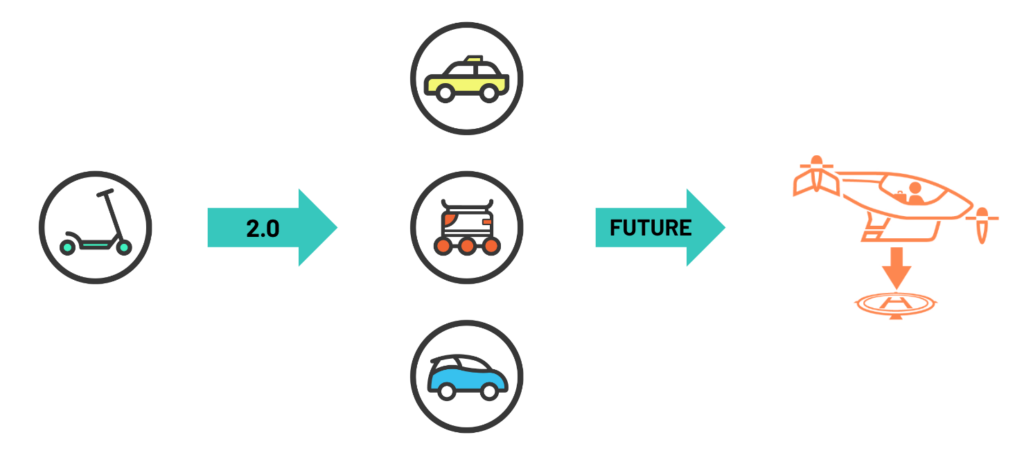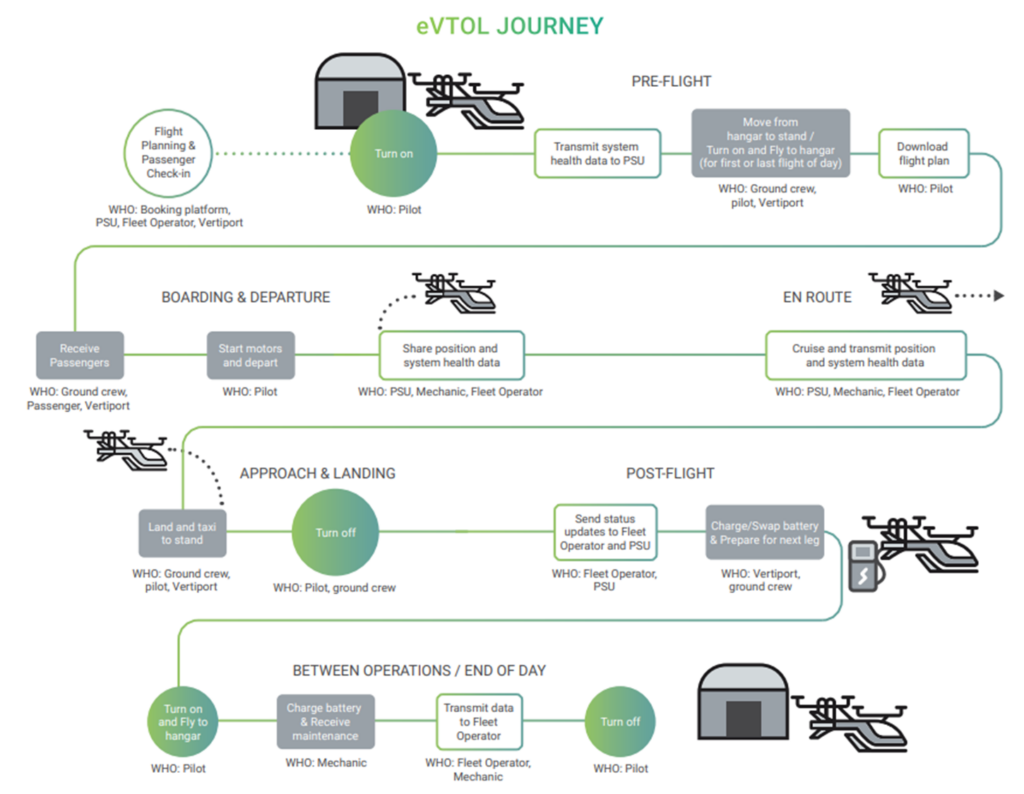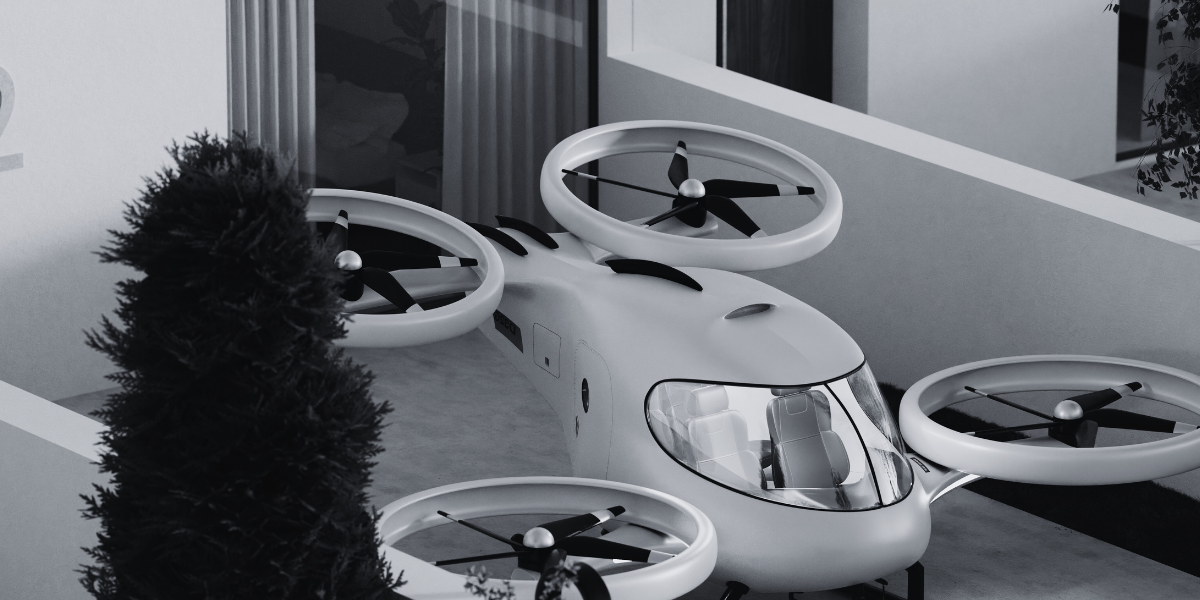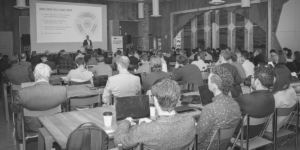ADVANCED AIR MOBILITY: TAKING OFF
With rapid advancements in technology, how will the future of air travel transform urban mobility? Companies and public agencies are investing in and developing policies around Advanced Air Mobility (AAM) – new aviation technologies that have the potential to revolutionize urban mobility by making air travel more accessible, efficient, and environmentally friendly. The OMF is taking a proactive role in helping cities prepare for the arrival of electric air taxis.
WHAT IS ADVANCED AIR MOBILITY?
Advanced Air Mobility (AAM) refers to new technologies and aircraft designed to provide safe, efficient, quiet, and sustainable aerial transportation. These include piloted electric vertical take-off and landing (eVTOL) vehicles (to transport passengers and cargo), and in the long term, aircraft with autonomous flight capabilities. These innovations can offer shared passenger services a new form of urban mobility and an alternative means for quick cargo transportation.
“AAM includes local use cases of about a 50-mile radius in rural or urban areas and intraregional use cases of up to a few hundred miles within or between urban and rural areas. AAM enables consumers’ access to air mobility, logistics, and emergency services by dispatching or using innovative aircraft and enabling technologies through an integrated and connected multimodal network across the ground, waterways, and skies.”
While eVTOLs that provide electric urban air taxi services might seem like science fiction, this technology is fast becoming a reality. The first eVTOLs are expected to start operations in the US in the next few years in advance of major events like the World Cup in 2026 or the Los Angeles-hosted Olympics in 2028. Efforts to prepare policy and infrastructure will need local governments to play an outsized role in engaging communities and determining when and where these aircraft can land and the conditions in which they can operate near communities. According to one recent article in the the LA Times, the FAA has cleared a California-based electric air taxi company to operate its aircraft commercially, with possible public launches in Newark or Chicago as early as 2025.
DRIVING CITY INNOVATION
At the Open Mobility Foundation (OMF), we focus on emerging transportation technology and digital infrastructure. Our goal is to help cities manage new trends, like the rise of shared e-scooters, and plan for emerging technologies, such as autonomous vehicles and AAM. Public agencies in the OMF community are interested in how AAM, like air taxis, might impact residents and connect with existing public transportation options. These agencies also have an important role in planning and approving new take-off and landing areas for AAM (called vertiports) and will consider the information sharing and other requirements needed to integrate this new mode of transportation into urban environments.
Ultimately, cities need a mix of policies, practices, and digital tools to manage public spaces for the public good. That’s why the OMF developed the Mobility Data Specification (MDS).
WHAT IS MDS?
MDS (Mobility Data Specification) is a tool that helps public agencies digitally manage transportation in public spaces. It includes a set of APIs that standardizes communication and data-sharing between cities and private mobility providers. This allows cities to share and validate policy digitally, enabling better vehicle management and outcomes for residents. MDS is free, open-source, and helps cities manage mobility in ways that prioritize safety, equity, and sustainability.
Data standards are a type of digital infrastructure that ensures different systems can share and use data consistently and securely. This standardization helps different technologies like new air mobility solutions integrate more seamlessly with public agency information systems. Standards also ensure data is accurate, reliable, and protected. For example, the Mobility Data Specification (MDS) allows cities and transportation companies to exchange information effectively, improving urban planning and public safety.
Initially developed in 2018, MDS helped cities manage the rapid deployment of dockless e-scooters by providing cities with a standardized way to analyze data from mobility providers and ensure they followed rules and regulations. Since then, cities around the world have been using MDS to improve safety, infrastructure planning, and access to public transportation. MDS 2.0, released in May 2023, expanded its use to include passenger services like taxis, robotaxis (Waymo/Cruise), ride-hail services (Lyft/Uber), car share, and delivery robots.

As cities and companies turn their eyes to the sky, it’s possible to adapt MDS for use with AAM.
SUPPORTING SAFE, SUCCESSFUL AIR MOBILITY
The OMF hosted several public working group meetings and discussions with industry and civic leaders, including Eve Air Mobility and cities including Los Angeles, Orlando, San Francisco, and Chicago to explore how MDS and data could ensure safe and successful AAM deployment. The discussions focused on shared passenger (i.e. air taxis) and cargo flights (as opposed to drones or personally-owned eVTOLs) and flights that include new vertiports or repurposed heliports within urban areas, as these require city planning and land-use consideration and approval. Together, we walked through representative eVTOL and passenger journeys to discuss the types of information that needs to be exchanged between public agencies, vertiport operators and eVTOL fleet operators at different stages of the journeys.

These sessions identified important MDS use cases for AAM, such as:
- Understand the best locations for vertiports, including transit and ground transportation connectivity
- Emergency response no-fly zones due to unplanned events, natural disasters and other emergencies
- Safety reporting, incident analysis, and maintenance requirements
- Adherence to policies, rules, and geofencing
- Assessing fees, incentives, and revenue sharing
- Deployment and usage in underserved (i.e. Justice40) areas to meet equity goals
- Addressing noise levels, and visual and environmental pollution
- Jurisdictions need to be the authority using data to respond and take action when needed
Next, we assessed the data required to meet these use cases, much of which is already partially supported in MDS 2.0. And, while we believe this accurately reflects what is most important to cities, not every type of information is equally important – nor necessary – for cities and companies to begin AAM pilot programs.
| CATEGORY | INFORMATION | MDS 2.0 SUPPORT |
| Safety | Emergency and special event communications | Partially Supported |
| Vehicle air and ground conflicts | Partially Supported | |
| Passenger safety | Partially Supported | |
| Hazardous materials in flight | Not Supported | |
| Flight paths | Partially Supported | |
| Incident, issue, and crash data | Not Supported | |
| Vertiport inspection, standards, compliance | Not Supported | |
| Equity and Access | Equity and privacy | Partially Supported |
| Jobs and access | Not Supported | |
| Transit and hub connections | Partially Supported | |
| Customer complaints | Not Supported | |
| Environment | Noise levels | Not Supported |
| Visual and environmental pollution | Partially Supported | |
| Battery health and capacity | Not Supported | |
| Efficiency | Vertiport availability and status | Partially Supported |
| Vertiport security | Not Supported | |
| Capacity | Take-offs and landings | Partially Supported |
| Passenger counts | Partially Supported | |
| Operations | Vehicle properties, condition, age, safety features, maintenance | Partially Supported |
| Fees and incentives | Partially Supported | |
| Vehicle movement/maintenance outside of trips | Partially Supported | |
| Vehicle status and state | Partially Supported | |
| Flight plan, departure time, destination, rerouting | Not Supported | |
| Pilot or AV software details | Not Supported |
THE CITY OF THE FUTURE IS ANCHORED IN DIGITAL POLICY
Ultimately, the use of digital policy — exchanging precise, up-to-date information digitally between cities and operators — will be key to ensuring AAM operates smoothly in urban environments. As an open-source standard, MDS will evolve through contributions from individuals and organizations. To fully adapt MDS for use with this emerging mode of transportation, cities must refine use cases to meet local equity, access, safety, and sustainability goals (see the “LADOT Data Reporting” section of their UAM Policy Framework Considerations for a great example). And companies will need to work with public agencies to build, test, and learn from deployments.
MDS is a common language that allows public agencies to share and validate policy digitally, communicating in a computer-readable format with mobility providers that operate on public streets and sidewalks. This reduces reliance on manual and less accurate forms of communication – like email, text messages, social media, and phone calls – to communicate important information like emergency response zones, speed limits, and designated parking areas.
There are some clear next steps to adapt MDS for use with AAM. After refining use cases and further assessing the data required to meet them, members of the OMF community will need to draft suggested changes to the spec and bring them to our public MDS Working Group meetings. The OMF provides facilitation and a reliable, trusted governance model that allows different stakeholders in the community to propose changes and to have those changes reviewed, critiqued, and improved by other community members. This collaborative space results in a better specification, one that’s been “stress tested” in advance by the people who will use it.
To get involved in the MDS Working Group:
- Review the MDS Working Group wiki to learn about the group’s work
- Get announcements and meeting agendas from the MDS mailing list
- Join monthly meetings (Thursdays, 12 pm ET) to discuss issues and hear from other contributors
- Follow the progress and contribute to our MDS repository
And, get caught up on OMF’s prior meetings and other relevant information related to AAM:
- Working Group Part 1
- Working Group Part 2
- GitHub Discussion
- Principles of the Urban Sky
- LADOT’s UAM Policy Framework Considerations (mentions sample language for requiring MDS)
- APA Planning for Advanced Mobility (discusses MDS)
Want to read or share this as a PDF? Download as a white paper.




